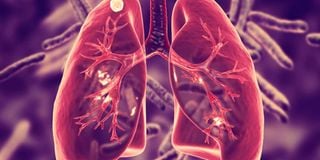Meru, Isiolo intensify hunt for TB patients

The number of undetected cases of tuberculosis (TB) remains high in Meru County and its environs as many patients avoid hospitals and take over-the-counter medication.
The National Tuberculosis, Leprosy and Lung Disease Programme (NTLD) report for 2021 shows a 48 percent drop in TB detection attributed to the Covid-19 pandemic.
Meru TB coordinator Eunice Kanana said that due to the biting drought in the region they are on high alert as malnutrition can trigger TB. About 60 percent of TB patients in Meru are malnourished.
In 2021, Meru was ranked second in Kenya’s TB burden, recording the second highest number of drug-resistant TB after Nairobi.
Meru recorded 3,818 TB cases in 2021 compared with Nairobi’s 10,598 and Kiambu’s 3,735.
“The poor health-seeking behaviour among residents continues to delay detection of TB cases in the county. Most of the patients come in very late,” Ms Kanana said.
“Since TB is transmitted through the air, the unidentified patients continue spreading the disease, leading to the high burden.”
While the Ministry of Health previously advised that anyone with a persistent cough for two weeks be screened for TB, the strategy has changed, now requiring that any cough of any duration be suspected to be TB until proven otherwise.
TB cases
“By suspecting every cough, we are able to identify TB cases early enough and contain the community transmission,” Ms Kanana said.
Mr Guyo Boru, a resident of Gambela in Tigania East, Meru, who was diagnosed with TB in 2020 at the height of Covid-19, said timely diagnosis helped him recover within seven months.
The high TB burden in Meru puts neighbouring Isiolo and Tharaka Nithi at risk, according to Duncan Barkebo, the USAID-funded Centre for Health Solutions (CHS) TB Accelerated Response and Care (TB ARC II) Upper Eastern project coordinator.
Isiolo recorded 558 TB cases in 2021, while Tharaka Nithi had 941.
“One TB patient is capable of infecting up to 15 people every year. This is why it is very important to have every patient identified and put on treatment,” Mr Barkebo said.
Imenti South, Imenti North and Igembe North are the TB hotspots in Meru, while Isiolo town accounts for most of the cases in Isiolo County.
The WHO End TB strategy aims to reduce the incidence rate from the current 261 per 100,000 people to 10 per 100,000 by 2030.
The goal is to reduce TB deaths by 90,000 and the TB incidence by 80 percent.
The TB ARC II programme in the Upper Eastern region, Mr Barkebo said, seeks to intensify identification of TB cases, improve diagnosis and ensure full recovery of patients.
Trunat diagnosis
In Meru, six GeneXpert and two Trunat diagnosis equipment have been installed in several sub-county hospitals to ease testing.
In neighbouring Isiolo, four diagnosis machines have been acquired, making it easier for patients to receive screening results within an hour.
“The intention of the TB ARC II programme is to enhance case finding, diagnosis and quality of care. If more people are reached and treated, we will be able to lower the TB burden,” Mr Barkebo said.
Ms Kanana, the Meru TB coordinator, said to reach more patients, they are also involving private health facilities in screening.
“All private facilities are required to refer any presumed TB case to the diagnostic sites across the county. This will ensure any patient suspected to have TB can be identified irrespective of where they seek medical care,” Ms Kanana said.
The approach also involves using motorcycle delivery drivers, who collect sputum from health facilities in any part of the county and deliver it to TB diagnostic centres.
“Currently, you can walk into any health centre or dispensary and we are able to screen for TB,” she said.
The setting up of a clear referral system has fast-tracked identification of cases in the area, said Isiolo sub-county TB coordinator Frank Marangu.




